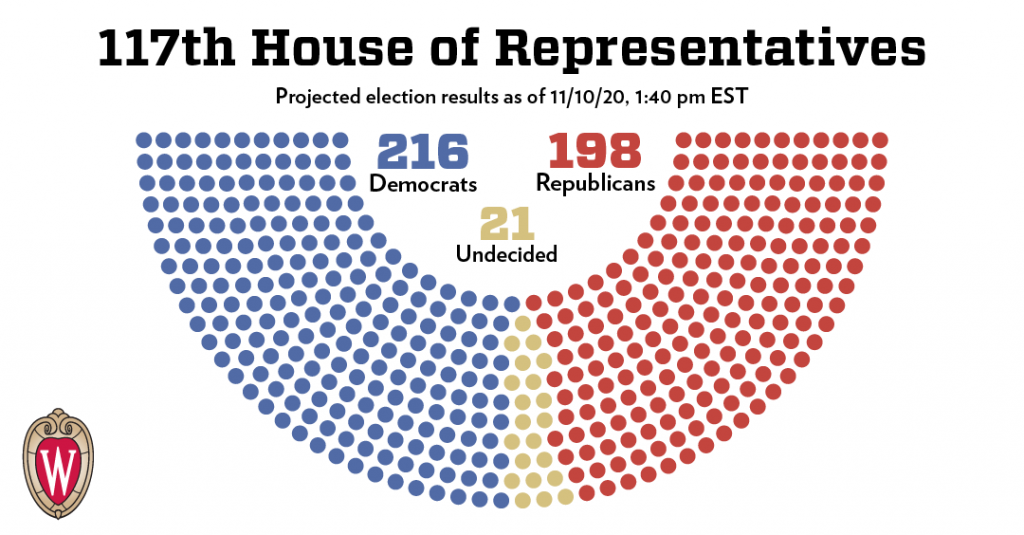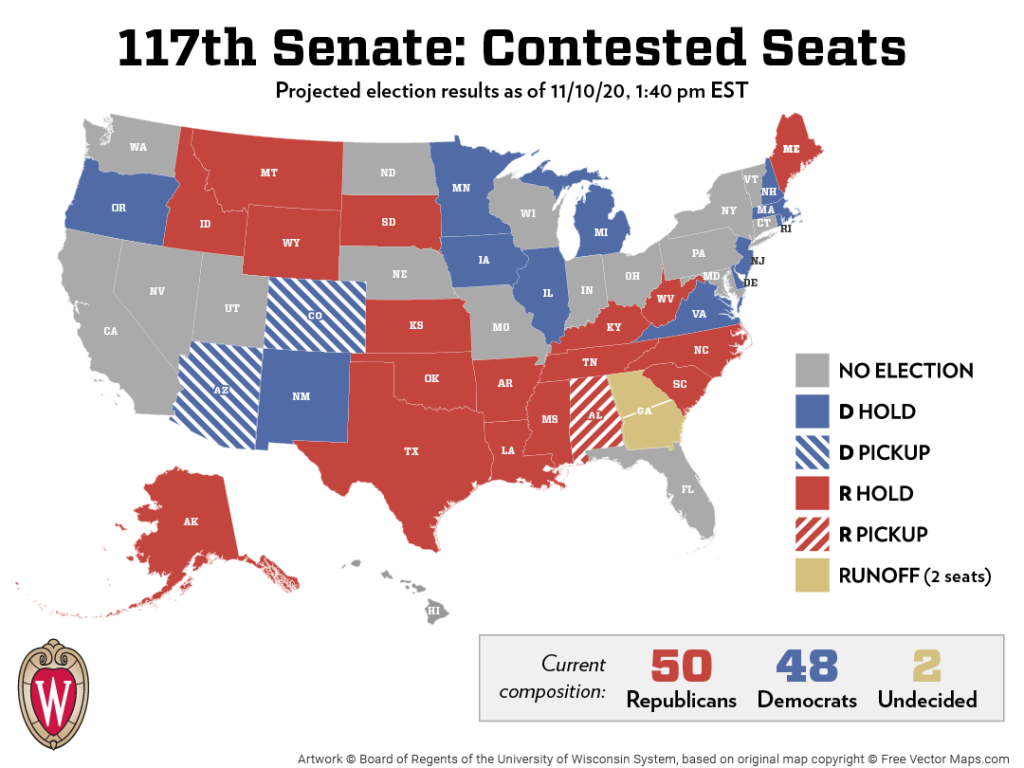Former Vice President Joe Biden secured victory over President Trump this weekend. The Trump campaign has filed lawsuits to challenge results and procedures in a number of states, but barring any changes to the current electoral college landscape it looks like President-elect Biden will be in the White House on January 20, 2021.
The 46th president will soften the political tone compared to what we’ve grown accustomed to hearing the past four years. He will have his work cut out trying to heal divisions in a deeply divided country, and likely with a divided Congress—Democrats continue to control the House of Representatives, albeit with a smaller majority, and while Senate control won’t be decided until two runoff elections take place in Georgia in January, Republicans are favored to hold at least one of the seats. However, if Democrats are able to win both seats, they would control the 50-50 Senate (including the two independents who caucus with Democrats) with Vice President-elect Kamala Harris in position to break ties.
If there is one man in Washington who is suited to work across the political aisle and get results, it’s Joe Biden. He is friends with many Senate Republicans, some of whom he served with for decades. He also negotiated major bills with Republicans while serving as vice president. His measured approach may be the cure for Washington gridlock and produce legislative achievements—we will find out soon as President-elect Biden embarks on his 100-day agenda. More information about his transition plans can be found on his website.
Before Joe Biden is sworn in as the nation’s 46th president, Congress needs to wrap up unfinished business. Below, you will find our outlook for the upcoming lame duck session and a look ahead to what to expect in the early days of a Biden administration.
Lame Duck Outlook
Congress will return to Washington next week to continue its legislative work. In addition to the must-pass legislation on its plate, such as passing a funding bill to avoid a government shutdown on December 11, Senate Majority Leader Mitch McConnell (R-Ky.) also said another coronavirus relief/stimulus bill should pass before the end of the year. Leader McConnell will also press for the confirmation of additional federal judges while President Trump remains in the Oval Office.
Earlier this year, the House passed 10 of the 12 annual spending measures, largely along party lines. Senate appropriators released their versions of the spending bills today. Congressional leaders in both parties are aiming to wrap up fiscal year (FY) 2021 spending bills this year. However, if Congress is unable to find compromise on the annual appropriations bills during the lame duck, a continuing resolution that extends funding to sometime early next year may be the most likely path to avoid a government shutdown.
House Speaker Nancy Pelosi (D-Calif.) also hopes to shepherd a coronavirus relief deal through Congress during the upcoming lame duck session to provide President-elect Biden with a clean slate when the 117th Congress begins in January. Senate Republicans, with the election in their rear-view mirror, may be willing to vote in favor of providing much-needed relief to Americans before the holidays. Complicating matters, it’s unclear if President Trump will sign a large bill into law after losing. It’s possible the must-pass FY 2021 spending bill turns into a “Christmas tree,” or legislative vehicle that gets loaded with a relief package and other extraneous provisions as lawmakers try to complete the 116th Congress.
The University of Wisconsin–Madison has joined other institutions of higher education in urging Congress to provide at least $120 billion for higher education relief to support institutions and students, $26 billion to aid in research relief, tax relief provisions that benefit public institutions, and liability protections in the next coronavirus relief bill.
The annual defense policy bill remains a top item for Congress’ to-do list in the lame duck session. Leaders of the House and Senate Armed Services Committees still have a long list of issues to resolve that will impact not only defense research policy but also international students. For example, the House NDAA includes language affirming that international students enrolled in online coursework can maintain their visa status for the duration of the COVID-19 public health emergency.
In addition to the aforementioned issues, a number of other topics may be on tap for the lame duck session, including relief for airlines should a COVID package remain elusive, expiring public health authorities, and expiring tax provisions, just to name a few.
117th Congress Outlook


It’s been over a decade since Democrats controlled the White House and both chambers of Congress. At that time, they passed a nearly $1 trillion economic stimulus bill in the wake of the Great Recession, the Affordable Care Act, and the Dodd-Frank financial services industry overhaul. Those policies arguably led to Republicans retaking the House and Senate in 2010, but look for Democrats to embark on a similarly ambitious agenda at the start of the new Congress in January.
At the other end of Pennsylvania Avenue, President-elect Biden will get to work right after his inauguration on January 20, 2021. He has pledged to make the Deferred Action for Childhood Arrivals (DACA) program permanent on his first day in office. President-elect Biden will also move to quickly withdraw a number of other executive orders issued by President Trump and issue his own new orders. He will also look to pull back additional pending rules. Look for him to rescind the Trump Administration’s Title IX guidance on sexual assault and harassment early in his term. However, he will need Congress’ help to unwind others.
If you’re not already familiar with the Congressional Review Act (CRA), you will be soon. Without getting too deep into the weeds, the CRA is a tool Congress can use to overturn executive branch actions issued in the final months of an outgoing administration. President Trump and Republicans used it to overturn more than a dozen regulations approved in the final year of President Obama’s administration, and now Democrats will use it to nullify a number of Trump’s executive actions. While it’s hard to predict which rules are subject to the CRA, a rough estimate is that any rule or action issued since June 1, 2020, might be susceptible to this process.
In addition to utilizing the CRA, Democrats will work quickly to enact their progressive agenda. Speaker Pelosi last week said H.R. 1 would “reduce the role of big, dark, special interest money” in politics. She also cited building infrastructure “in a green way” and addressing prescription drug prices as priorities.
Democrats will use their majorities to tackle immigration reform as well. There are few policy areas where President Trump and congressional Democrats are farther apart than immigration. They differ on almost every major immigration policy issue, including DACA, family reunification, asylum, visa requirements for international students, and the border wall. A Biden administration and Democratic majorities in Congress are sure to bring a sea change in immigration policy.
Another complete turn we’re expecting is a commitment to increasing scientific research funding. The past four years have seen large proposed cuts to federally funded research. Among other research areas, President-elect Biden has promised “the largest-ever investment in clean energy research and innovation.” Other pledges include $300 billion over four years for research and development and “breakthrough technologies,” and billions of dollars to seek cures for diseases like cancer, diabetes, and Alzheimer’s.
When it comes to higher education, President-elect Biden has released a comprehensive higher education plan that would invest in community colleges, make college more affordable, and provide debt forgiveness.
Of course, if Congress is unable to finish FY 2021 spending bills or pass a coronavirus relief package during the lame duck, those two big-ticket items would move to the front of the line come January. Regardless, it is certain to be an eventful and legislatively-packed first six months of the Biden administration.